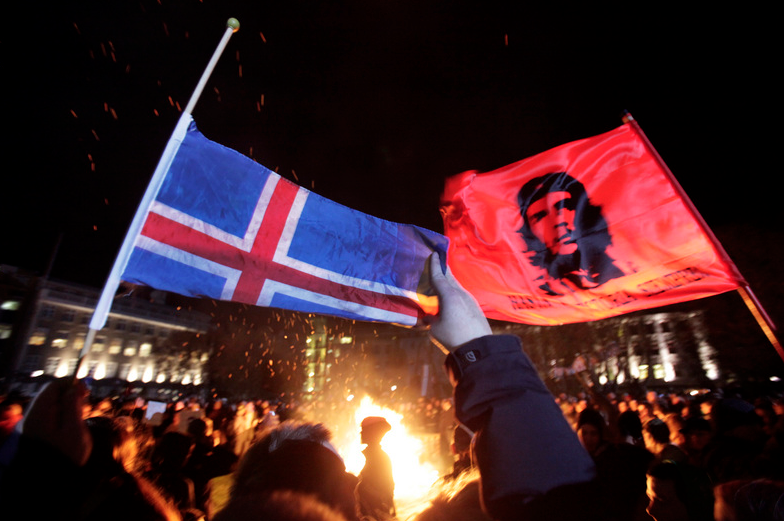The demonstrations in France are getting a fair amount of play at the moment, not least because street spectacles provide more dramatic photographs than mortgage foreclosure practices or candidate debates. Amidst the tear gas, rioting youth, and phalanxes of police, this photo caught my eye.
![]()
The large reproduction of the iconic image of Che Guevara surely is the point of the photo: otherwise we are looking at someone’s back, a flare in daylight, and a jumbled background of smoke and signage. The man wearing the icon is a worker with the Solidaires union, which was part of the protest against pension reform. The French government has proposed raising the retirement age to 62, and in response hundreds of thousands of demonstrators have been taking to the streets. The government estimate for yesterday was 800,000 demonstrators. That’s right: 800,000, to fight raising the age to 62. Such numbers do not compute in the US.
And wait a minute. . . . Che, a symbol of the welfare state? Isn’t this another example of how the French left is out of touch, living in a fantasy world? Well, that’s one interpretation, but it can’t hold if it is specific to France.

This photo is from Reykjavik, Iceland. The issue isn’t pension reform per se, but rather housing and other issues believed to be examples of the government’s inadequate response to the economic crisis that began with the financial meltdown in 2008. So, much the same as above, people are taking to the streets to demand government action on behalf of social democracy. So it is that young people can be demonstrating for pension plans, and that Che can be a symbol of progressive response to the global recession caused by financial mismanagement abetted by neoliberal economic policies.
If you type “Che” into Google Image, you’ll quickly see that this icon is already an object of conservative parody and invective, and the examples above certainly are fair game in that regard. That’s not all that can be said, however. For one, they are examples of how iconic images are used in ways that go well beyond their original context, and how that can include become a visual relay on behalf of both specific solidarities and public culture generally. In photographing the iconic photograph, the press is reporting on one of its own visual processes for creating a public world, and here that world is one in which workers are united across national borders.
That’s the good news. There also is this: the transformation of Che from a socialist revolutionary into a symbol of the European social contract may be one indication of just how far the Western democracies have been pushed to the right. I’ve never been a fan of faux revolutionaries, and the Che icon certainly played to that, but it’s sad to think that revolution on behalf of economic justice has come down to holding the line on a pension plan. Pensions are very important, of course, but there is so much more that needs to be done. A post-revolutionary society may be not only more realistic but also a step forward on the march of progress, but only if governments accept that their job is to protect ordinary people from the ravages of a market economy. Surely that standard is not being met when the people have to beg government to not sell them out.
Photographs by Pascal Rossignol/Reuters and Thorvaldur Kristmundsson/ZUMApress.com.
I think that the image of Che Guevara on this blog represents an example of reproduction of image. Che is a hero of leftist politics in Latin America, especially in Cuba. After the image of Che has circulated throughout the world, the image has become and broad icon of revolutionary socialist politics. Moreover, reproductions of the image are often too abstract, or used for market purpose such as mouse pads, t-shirts, or tote bags. In my country, Japan, I used to see a lot of products which are using the image of Che, and I used t think that Che is just a model from some Latin American country. This happened because of course I did not learn about Latin political history, and there are too many commercial products in Japanese market. People who are not informed tend to get confused or misunderstand about the true meaning of images because of reproduction, and images are used over the countries, and for many purposes. Or because reproduction works for altering meaning of images, people can even take the meaning of the image differently, so people tend to apply the image of Che for different purpose, thus we see this image of Che across the countries. As this blog article says, we can measure the change and movement of political ideas over countries. I think this is an interesting effect of reproduction of image, and I hope that we will be more curious about reproduced images and explore about the original meaning of those reproduced images.
I think that the social and political charged image of Che was used to heighten the message of the protesters depicted in the photo. But this reproduction of Che Guevara, as the blogger describes, has taken on a diverse and divergent meaning “well beyond the original context”. The aggrandizement of his myth translated through many “reproductions” is in some ways broken up or is dumbed down to the point where his image is just an abbreviated and generalized significance. The image of Che Guevara has transformed from its historical significance and has become an popular culture icon and tool for those who wish to borrow its visibility and significance for their own cause be it for true political revolution or protests for keeping their welfare.